#Best dog shampoo for yeast infection
Explore tagged Tumblr posts
Text
How Often Should You Shampoo Your Dog?
Bath time with your dog can be a splashy adventure, but how often should you actually shampoo your furry friend? It’s a common question that dog parents ask. The answer isn’t one-size-fits-all. It depends on a variety of factors like breed, coat density, fur length, and even the season. For instance, using the best hypoallergenic dog shampoo might be ideal for dogs with sensitive skin, while the best dog shampoo for yeast infection is necessary for those prone to skin issues.
For more information, visit: https://thegloblenews.com/how-often-should-you-shampoo-your-dog/
#Best hypoallergenic dog shampoo#Best dog shampoo for yeast infection#Antibacterial antifungal dog shampoo#Best moisturizing dog shampoo#Best oatmeal dog shampoo for itchy skin#Dog shampoo for dry skin
0 notes
Text
Battling Skin Infections: A Dog Owner's Survival Guide"

As a dog owner, your furry friend's health and happiness are of utmost importance. One common health issue that can plague our canine companions is Skin infections in dogs. These infections can be uncomfortable and distressing for both you and your dog. However, armed with knowledge and proper care, you can effectively battle and prevent skin infections in your four-legged friend. In this guide, we will explore the causes, symptoms, treatment options, and prevention strategies to help you become a skin infection superhero for your beloved pet.
Understanding Skin Infections in Dogs
Skin infections in dogs can manifest in various forms, and they are typically caused by bacteria, fungi, or parasites. Understanding the underlying causes is crucial for effective management. Here are some common culprits:
Bacterial Infections: Staphylococcus and Streptococcus bacteria are often responsible for bacterial skin infections. These infections can occur when the skin barrier is compromised, allowing bacteria to infiltrate.
Fungal Infections: Fungi like yeast and dermatophytes can lead to fungal skin infections. These often occur in warm and moist areas of a dog's body, such as the ears, paws, and folds of skin.
Parasitic Infections: External parasites like fleas, ticks, and mites can cause skin irritations and infections. These parasites not only bite but can also transmit diseases that affect your dog's skin.
Click here to know more : -
Recognizing the Symptoms
Identifying the signs of a skin infection in your dog is crucial for prompt treatment. Common symptoms of skin infections in dogs include:
Itching: Dogs with skin infections often exhibit excessive itching and scratching. This can lead to hair loss and irritated skin.
Redness and Inflammation: The affected area may appear red, swollen, and warm to the touch.
Pustules or Pimples: Bacterial infections may cause pustules or pimple-like lesions on the skin.
Hair Loss: Dogs may experience localized or generalized hair loss in the affected area.
Odor: Skin infections can produce a foul odor, especially in cases of yeast overgrowth.
Open Sores or Wounds: Scratching and licking can lead to open sores and wounds, which may become infected.
Changes in Behavior: Your dog may exhibit signs of discomfort, restlessness, or changes in behavior due to the discomfort caused by the infection.
Seeking Veterinary Care
If you suspect your dog has a skin infection, it's crucial to consult with a veterinarian. They can diagnose the specific type of infection and recommend appropriate treatment. Treatment may involve:
Medication: Depending on the diagnosis, your vet may prescribe antibiotics for bacterial infections, antifungal medications for fungal infections, or parasitic control products for parasitic infections.
Topical Treatments: In some cases, topical treatments like shampoos, sprays, or ointments may be recommended to alleviate symptoms and promote healing.
Preventive Measures: Your veterinarian may provide guidance on preventing future skin infections. This might include recommendations for regular grooming, cleaning ears, or using parasite preventatives.
Dietary Changes: Dietary modifications, such as switching to a hypoallergenic or specialized diet, may be suggested for dogs with recurring skin issues.
Preventing Skin Infections in Dogs
Prevention is often the best strategy when it comes to skin infections in dogs. Here are some proactive steps you can take as a responsible dog owner:
Regular Grooming: Regular grooming is essential to maintaining your dog's skin health. Brushing your dog's coat helps remove loose hair, prevents matting, and promotes good circulation, which can reduce the risk of skin infections.
Clean Ears: If your dog is prone to ear infections, cleaning their ears regularly can help prevent issues. Use a vet-recommended ear cleaning solution and follow your veterinarian's advice.
Parasite Control: Keep your dog on a consistent flea and tick prevention regimen. Check your dog for parasites after walks or outdoor activities, and promptly remove any ticks you find.
Balanced Diet: Feeding your dog a balanced and high-quality diet can help support their overall health, including skin health. Consult with your veterinarian for dietary recommendations if your dog has a history of skin problems.
Hygiene: Bathing your dog with a mild, pet-friendly shampoo can help remove dirt and allergens from their skin. Be sure not to over-bathe, as excessive bathing can strip the skin of its natural oils.
Environmental Management: Keep your dog's living environment clean and dry. Wash their bedding regularly, vacuum your home to remove allergens, and ensure your dog has a comfortable and clean living space.
Regular Veterinary Check-Ups: Routine check-ups with your veterinarian are essential for detecting and addressing potential health issues before they become major problems.
In Conclusion
Skin infections in dogs can be a source of discomfort and concern for both you and your furry friend. By understanding the causes, recognizing the symptoms, and taking preventive measures, you can become a skin infection superhero for your canine companion. Remember, if you suspect a skin infection or any other health issue in your dog, consult your veterinarian promptly for expert guidance and treatment. With proper care, you can ensure that your dog's skin stays healthy, allowing them to lead a happy and itch-free life.
Read more : - When to Worry: Signs Your Dog Needs Cough Medicine
3 notes
·
View notes
Text
Natural Ingredients in Puainta’s Medicated Dog Shampoo: Combining Science and Nature for Healthier Skin
Caring for your dog’s skin requires the right shampoo, and Puainta’s medicated dog shampoo offers an ideal solution by combining the best of nature and science. This carefully crafted formula is both gentle and highly effective, addressing common skin issues like dryness, itching, and infections. With its high-quality natural ingredients, Puainta ensures that your dog gets the care it needs for healthier skin. In this article, we’ll explore the powerful ingredients in Puainta’s medicated dog shampoo, how its scientific formula works, and why Puainta is the top choice for promoting your dog’s skin health.

The Power of Nature: Key Ingredients in Puainta’s Medicated Dog Shampoo
One of the standout features of Puainta’s medicated dog shampoo is its carefully selected, natural ingredients. These ingredients work together to treat a variety of skin problems while being gentle and soothing for your dog.
Chamomile: Known for its anti-inflammatory properties, Chamomile helps reduce redness and soothe irritated skin. It’s particularly beneficial for dogs with sensitive skin, providing relief from discomfort caused by allergies or infections.
Coconut Oil: This natural oil is a moisturizing powerhouse that helps hydrate dry skin, reducing flakiness and itching. Coconut oil also has antimicrobial properties that help protect the skin from further damage caused by bacteria or fungi.
Rosemary: A powerful antioxidant, Rosemary helps to stimulate circulation and promotes healthy skin. It also has natural antifungal and antibacterial qualities, making it perfect for addressing common skin infections.
Sophora Flavescens: A traditional herb known for its antifungal and antibacterial properties, Sophora Flavescens helps to combat conditions like ringworm and other fungal infections.
Each of these natural ingredients in Puainta’s medicated dog shampoo plays a key role in supporting your dog’s skin health, ensuring they receive both effective treatment and gentle care.
Science Behind the Formula: How Puainta Works to Treat Skin Problems
While natural ingredients are important, the science behind Puainta’s medicated dog shampoo is what makes it truly effective. The formula is designed to penetrate deeply into the skin, addressing the root causes of common skin problems.
For example, the combination of soothing botanicals like Chamomile and Coconut Oil ensures that your dog’s skin is not only treated but also protected from future flare-ups. The shampoo’s antifungal and antibacterial properties help tackle conditions like dandruff, yeast infections, and ringworm, while the nourishing oils keep the skin hydrated and calm.
By harnessing both nature and science, Puainta provides a comprehensive solution to your dog’s skin problems, addressing symptoms and promoting long-term skin health.
Why Choose Puainta: Combining Safety, Effectiveness, and Natural Care
When it comes to choosing a medicated dog shampoo, Puainta stands out for its commitment to safety, effectiveness, and natural care. Many shampoos contain harsh chemicals that can worsen skin conditions or cause irritation, but Puainta’s medicated dog shampoo is free from harmful additives, making it a safer choice for your dog.
Not only does Puainta provide relief from symptoms, but its natural, plant-based formula helps to heal and protect the skin over time. Regular use can improve the overall condition of your dog’s skin, reducing the likelihood of recurring problems. Whether your dog is struggling with dry skin, allergies, or a bacterial infection, Puainta offers a trusted solution that combines the healing power of nature with the precision of science.
Conclusion
In conclusion, Puainta’s medicated dog shampoo is the perfect choice for dogs with skin issues. Its combination of natural ingredients like Chamomile, Coconut Oil, Rosemary, and Sophora Flavescens, along with the science-backed formula, provides a safe, effective, and gentle solution for healthier skin. Choose Puainta today and give your dog the relief it deserves.
0 notes
Text
How to Soothe Dog's Itchy Skin? Effective Remedies and Tips
If your dog is constantly scratching, licking, or biting at their skin, they may be dealing with itchy skin. This common issue can be caused by a variety of factors, from allergies to dry skin, and it can greatly affect your pet's comfort and health. At Unleash Wellness, we know how important it is to relieve your dog’s discomfort, so here are effective ways to soothe a dog’s itchy skin.
1. Determine the Cause of Itchy Skin
Before you can effectively soothe a dog’s itchy skin, it’s essential to understand what’s causing it. Common triggers include:
Allergies: These can range from food allergies to environmental allergens like pollen or dust.
Fleas and Parasites: Fleas and mites can cause significant irritation, leading to intense scratching.
Dry Skin: Changes in temperature, frequent baths, or harsh shampoos can lead to dry, flaky skin.
Infections: Bacterial or fungal infections can also lead to itching and require proper treatment.
Identifying the cause is the first step in learning how to soothe a dog’s itchy skin. This will help you choose the best treatment options and avoid future flare-ups.
2. Home Remedies to Soothe Your Dog’s Itchy Skin
Sometimes, simple home remedies can work wonders in relieving your dog’s itchiness. Here are a few popular and effective remedies:
Oatmeal Baths: Oatmeal has natural soothing properties, which can provide instant relief for itchy skin. You can grind plain oatmeal into a fine powder, mix it with warm water, and allow your dog to soak for 10-15 minutes.
Aloe Vera Gel: If your dog has patches of red, irritated skin, applying pure aloe vera gel can help cool and soothe the area. It’s best to use aloe vera without added chemicals, so check the label carefully.
Coconut Oil: Coconut oil can be massaged into your dog’s skin to moisturize dry areas and provide itch relief. It also has antibacterial properties, making it an excellent choice for dogs with minor skin irritations.
Trying these remedies is a great step towards understanding how to soothe a dog’s itchy skin naturally. At Unleash Wellness, we recommend trying these remedies first before opting for medicated treatments, especially for mild symptoms.
3. Dietary Adjustments to Promote Skin Health
Diet plays a significant role in skin health, and food allergies can often contribute to itching. If you suspect food allergies, try switching to a limited-ingredient or hypoallergenic diet under the guidance of your vet. Adding omega-3 and omega-6 fatty acids to your dog’s meals can also help improve their coat’s shine and moisture, reducing itchiness over time. These supplements, often found in fish oils, can provide soothing relief for your dog’s itchy skin and promote overall skin health.
4. Choose the Right Products for Bathing and Grooming
Bathing your dog too often, or using harsh shampoos, can strip away natural oils, leading to dry skin. Opt for a gentle, hypoallergenic dog shampoo that’s designed to moisturize and soothe itchy skin. Some shampoos contain ingredients like oatmeal, aloe vera, or tea tree oil, which can help calm irritation. For additional support, Unleash Wellness offers dog grooming products that cater to sensitive skin needs, ensuring a gentle and effective clean without causing further dryness or itchiness.
5. Consult Your Vet for Persistent Itching
If the itching persists despite trying various remedies, it’s essential to consult your veterinarian. They can help identify if there’s an underlying medical condition, such as a bacterial infection, yeast infection, or skin allergy that requires more targeted treatment. In some cases, your vet may prescribe medicated shampoos, anti-inflammatory medications, or topical treatments to effectively manage your dog’s itchy skin.
Understanding how to soothe a dog’s itchy skin is about being observant of their symptoms and proactive in finding relief. While many home remedies and diet adjustments can be beneficial, a consultation with your vet is always advised for more severe or prolonged itching.
Final Thoughts
Addressing and managing itchy skin in dogs can make a world of difference in your pet’s comfort and quality of life. With the right care, products, and professional advice, you can provide effective relief. For more information and products specifically tailored for pet wellness, visit Unleash Wellness—where we’re dedicated to keeping your furry friend healthy and happy.
Now that you know how to soothe a dog’s itchy skin, you’re ready to start helping your dog feel better. Remember, the journey to wellness is a partnership between you, your pet, and trusted resources like Unleash Wellness!
0 notes
Text
5 Grooming Mistakes Even Experienced Owners Make
Every pet parent wants their furry friends to look and feel their best. However, even the most experienced pet parents can fall into common grooming pitfalls. We at Paws in the Bath Toronto have seen it all when it comes to dog grooming in Toronto. That's why we've compiled a list of five common mistakes even experienced owners make, along with tips to keep your pup looking pawsome!

Skipping Brushing
Brushing is not just about keeping your dog’s fur smooth but also removes dead skin cells, prevents matting, promotes healthy skin by distributing natural oils, and allows for early detection of skin problems or parasites.
Over Bathing
Frequent bathing can cause the loss of natural oils from your dog’s coat, leading to itchy and sensitive to irritation. Although a clean pup is considered to be a happy pup, over-bathing may be detrimental to health. Frequent The ideal bath frequency depends on your dog's breed, activity level, and coat type.
Ignoring the Ears and Nails:
Filthy ears can become breeding grounds for bacteria and yeast infections. Ear and nails are often overlooked areas, but they need regular attention. Long nails can be uncomfortable for your dog to walk on and can even snag or break.
Using Human Hair Products
Additionally, a common mistake is using human shampoos or conditioners on dogs. Your favorite hair products might leave your locks silky smooth, but they can irritate your dog's skin and disrupt its pH balance. Always use products specifically formulated for dogs. At Paws in the Bath, we use high-quality, dog-friendly products to ensure your pet's coat and skin stay healthy.
Skipping Professional Grooming
Though routine at-home grooming is crucial, the professional grooming session shouldn’t be replaced entirely. The professionals have the experience and required tools to handle tricky grooming tasks and spot potential health issues that are hard to execute at home. Regular visits to a professional grooming salon like Paws in the Bath can complement your home grooming routine and keep your dog looking and feeling its best.
Final thoughts
By avoiding these common grooming mistakes you can significantly improve your dog's health and appearance. Don’t forget that proper grooming is more than just keeping your dog clean—it's an essential part of responsible pet ownership. If you're unsure about any aspect of your dog's grooming needs, don't hesitate to consult with professionals. At Paws in the Bath, we're committed to providing top-notch dog grooming services in Toronto. Our experienced groomers can guide you through the best grooming practices for your specific breed and help you avoid these common pitfalls. Visit our Toronto location to learn more about our services and how we can help keep your furry friend happy, healthy, and looking great.
1 note
·
View note
Text
Unleashing Bath Time Bliss: Finding the Perfect Dog Shampoo for Your Pup
Bath time with your furry friend can be a bonding experience or a hilarious mess – either way, choosing the right shampoo is key to a smooth and enjoyable process for both of you! This comprehensive guide dives into the delightful world of best dog shampoo, equipping you to navigate ingredients, address specific needs, and ultimately select the pawfect product for your cherished pup.
Ditching the Human Shampoo for Fido: Why It Matters
Human shampoo is strictly off-limits for dogs! Here's why:
pH Party Crashers: Dog skin has a unique pH balance compared to humans. Human shampoos can disrupt this delicate harmony, leading to dryness, irritation, and general discomfort for your pup.
Harsh Ingredients on the Loose: Many human shampoos contain harsh chemicals and fragrances that can irritate a dog's sensitive skin and eyes.
Missing the Mark on Coat Needs: Dog shampoos cater to specific coat requirements like shedding, matting, or odor control, which human formulas simply don't address.
Unveiling the Shampoo Smorgasbord: Different Types for Different Pups
The dog shampoo aisle can be overwhelming. Here's a breakdown of the most common types to help you find the perfect fit:
Puppy Power: Gentler and tear-free formulas ideal for those young, curious eyes and delicate puppy skin.
Flea & Tick Foes: Containing ingredients that vanquish those pesky fleas and repel future invaders. Caution: Always follow instructions meticulously and consult your veterinarian before using on pregnant or nursing dogs.
Medicated Marvels: Formulated to address skin conditions like allergies, yeast infections, and dandruff. Consult your veterinarian for diagnosis and recommendations.
Oatmeal Oasis: Soothe dry, itchy skin with the gentle power of oatmeal.
Shed Happens, Less Often: Minimize shedding by promoting a healthy coat and reducing loose hair.
Deodorizing Delights: Combat doggy odor with fresh, long-lasting scents.
Waterless Wonders: Perfect for quick cleanups or situations where a full bath isn't feasible.
Brightening Boosters: For white or light-colored coats, these shampoos can help enhance natural shine and remove minor stains.
The Tailored Touch: Selecting the Best Shampoo for Your Dog
Now that you know the different types, consider these factors when making your choice:
Coat Chronicles: Short-haired breeds may require a different formula than their long-haired counterparts. Similarly, curly-haired pups might benefit from shampoos that promote detangling.
Sensitive Souls: If your dog has allergies or sensitive skin, opt for hypoallergenic, fragrance-free shampoos.
Lifestyle Leash: Active dogs who get dirty frequently might need a more frequent and cleansing shampoo, while indoor companions may require less frequent bathing with a milder formula.
Specific Needs: Does your dog have shedding issues? Dry, itchy skin? Look for shampoos formulated to address those specific concerns.
Ingredient Intel: Choosing a Top-Rated Shampoo
When deciphering the shampoo label, keep an eye out for these pawsome ingredients:
Natural Nurturers: Oatmeal, coconut oil, aloe vera, and essential oils can soothe skin, promote healing, and nourish the coat.
Moisture Masters: Look for ingredients like lanolin or glycerin to prevent dryness and keep your dog's coat soft and shiny.
Vitamin E Power: Promotes a healthy coat and skin.
Ingredients to Avoid: Potential Irritants for Your Pup
While some ingredients may seem fancy, they can be problematic for dogs. Avoid these:
Sulfate Saboteurs: Harsh detergents that strip natural oils and cause dryness.
Alcohol Antics: Can be drying and irritating to the skin.
Artificial Fragrance Faux Pas: May irritate a dog's sensitive sense of smell and potentially trigger allergies.
Beyond the Bottle: Bath Time Essentials for a Smooth Experience
For a successful and enjoyable bath time, you'll need a few additional supplies:
Dog Shampoo: The chosen hero of this tale! Make sure it caters to your dog's needs.
Brush Buddies: Remove loose fur before bathing to prevent matting and make rinsing easier.
Shampoo Dispenser: Makes dilution and application a breeze.
Towel Trio: Plenty of absorbent towels for drying.
Washcloth Warriors: For cleaning the face and ears (avoid using soap in the ears).
Positive Reinforcement: Treats and praise go
0 notes
Text
The Eco-Friendly Choice: Natural Dog Shampoo from Cute Pet Essentials

When it comes to caring for our furry companions, pet owners are increasingly turning to eco-friendly and natural products. In this pursuit of a healthier and more sustainable lifestyle, even our pets deserve the best. One area where this trend is particularly prominent is in the grooming routine of our beloved dogs. Today, we'll explore the benefits of using natural dog shampoo, with a special focus on the antifungal properties and relief for itchy skin provided by Cute Pet Essentials' Natural Dog Shampoo.
The Rise of Natural Dog Shampoos-
The pet care industry has seen a significant shift towards natural and eco-friendly products in recent years, and for good reason. Traditional dog shampoos often contain harsh chemicals and synthetic fragrances that can be harmful to our pets and the environment. Natural dog shampoos, on the other hand, are formulated with plant-based ingredients that are gentle on your dog's skin and coat while being kind to the planet.
One of the key advantages of natural dog shampoos is their suitability for dogs with sensitive skin or those prone to allergies. They are free from harsh chemicals like sulfates and parabens, which can strip the skin of its natural oils and lead to irritation. Instead, natural dog shampoos like Cute Pet Essentials' offering prioritize ingredients that promote a healthy and balanced skin and coat.
Antifungal Properties for Healthy Skin-
Many dogs suffer from skin issues at some point in their lives, with itchiness and fungal infections being common problems. This is where an antifungal shampoo for dogs can make a significant difference. Cute Pet Essentials' Natural Dog Shampoo is an excellent choice for pet owners looking to address these concerns naturally.
The antifungal properties of this shampoo are derived from botanical ingredients like tea tree oil, neem oil, and aloe vera. These ingredients are known for their antifungal and antibacterial properties, which help combat fungal infections such as ringworm and yeast overgrowth. By using a natural antifungal shampoo, you can effectively treat these issues without resorting to harsh chemicals that may exacerbate the problem.
In addition to fighting fungal infections, Cute Pet Essentials' Natural Dog Shampoo also promotes a healthier skin microbiome. A balanced microbiome is crucial for your dog's overall skin health, as it helps prevent the overgrowth of harmful bacteria and fungi that can lead to itching and discomfort. By maintaining a healthy skin ecosystem, this natural dog shampoo provides long-term relief for itchy skin and promotes a shiny, lustrous coat.
Relief for Itchy Skin-
Itchy skin is a common problem among dogs, and it can be caused by various factors, including allergies, insect bites, or dryness. Traditional shampoos may provide temporary relief, but they often contain chemicals that can exacerbate the problem in the long run. Cute Pet Essentials' Natural Dog Shampoo takes a different approach by soothing and nourishing the skin, addressing the root cause of itching.
This natural dog shampoo contains ingredients like oatmeal and chamomile, which are well-known for their soothing properties. Oatmeal helps relieve itching and inflammation, making it a go-to ingredient for dogs with sensitive skin. Chamomile, on the other hand, has natural anti-inflammatory and calming effects, providing instant relief to irritated skin.
Furthermore, Cute Pet Essentials' Natural Dog Shampoo is pH-balanced to match your dog's skin, ensuring that it cleanses without stripping away the natural oils that protect and moisturize their skin. This gentle cleansing action is vital for dogs with itchy skin, as harsh shampoos can further dry out and irritate their already sensitive skin.
Environmental Benefits-
Choosing Cute Pet Essentials' Natural Dog Shampoo not only benefits your dog but also contributes to a healthier planet. The shift towards eco-friendly pet products is part of a broader movement towards sustainability and reduced environmental impact.
Natural dog shampoos are typically biodegradable and contain ingredients that are sourced responsibly. This means that when you use a natural dog shampoo, you're not only avoiding harm to your dog but also reducing the pollution of waterways and ecosystems with harmful chemicals.
Additionally, the packaging of Cute Pet Essentials' Natural Dog Shampoo is designed with sustainability in mind. Many eco-conscious companies are now using recyclable or biodegradable packaging, further reducing their carbon footprint.
Conclusion
In the quest for a more eco-friendly and pet-friendly lifestyle, natural dog shampoos have become a cornerstone of responsible pet care. Cute Pet Essentials' Natural Dog Shampoo stands out as an excellent choice for pet owners seeking relief for itchy skin and the antifungal properties they need to keep their dog's skin healthy.
By making the switch to natural dog shampoo, you're not only providing your furry friend with a gentler and more effective grooming experience, but you're also contributing to a cleaner and greener planet. So, why wait? Make the eco-friendly choice for your dog's well-being and give Cute Pet Essentials' Natural Dog Shampoo a try today. Your dog's skin will thank you, and so will the environment. For further insights, delve into our blog, "Essential Tools and Tips for a Well-Groomed Pet"
0 notes
Text
Home Remedies for Managing Minor Skin Infections in Dogs
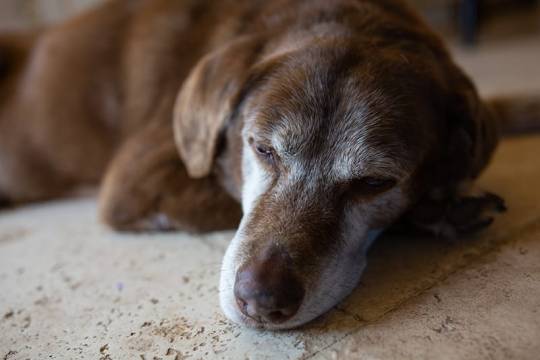
Introduction
Skin infections in dogs are a common concern among pet owners. These infections can be uncomfortable for your furry friend and may cause itching, redness, and even pain. While it's important to consult a veterinarian for proper diagnosis and treatment, there are several home remedies you can use to manage minor skin infections in dogs. In this article, we will explore these remedies and provide some helpful tips for keeping your dog's skin healthy and infection-free.
To know more about : -
Understanding Skin Infections in Dogs
Before we delve into home remedies, let's briefly discuss the common causes of skin infections in dogs. These infections can be triggered by various factors, including:
Bacterial Infections: Bacteria can thrive in the warm and moist environment of your dog's skin, leading to infections. Common bacterial infections include impetigo and folliculitis.
Fungal Infections: Fungi, such as yeast and ringworm, can cause skin issues in dogs. Fungal infections often lead to redness, itching, and hair loss.
Parasitic Infections: External parasites like fleas and mites can irritate your dog's skin, potentially leading to secondary infections.
Allergies: Allergic reactions to food, pollen, or other environmental factors can manifest as skin problems in dogs. These allergies may cause itching, inflammation, and redness.
Hot Spots: Hot spots are localized areas of inflamed skin that can result from constant licking, scratching, or biting due to an underlying issue.
Home Remedies for Managing Skin Infections in Dogs
Regular Bathing: Keep your dog clean by giving them regular baths with a mild, hypoallergenic dog shampoo. Bathing helps remove dirt, allergens, and potential irritants from their skin.
Apple Cider Vinegar: Diluted apple cider vinegar can help combat fungal and bacterial infections. Mix equal parts of water and apple cider vinegar, then apply it to affected areas using a cotton ball. Allow it to air dry. This remedy can help restore the skin's pH balance.
Aloe Vera Gel: Aloe vera has natural anti-inflammatory and soothing properties. Apply a thin layer of aloe vera gel directly to the affected areas to reduce itching and promote healing.
Coconut Oil: Coconut oil possesses antibacterial and antifungal properties. Gently massage a small amount of coconut oil onto your dog's skin to alleviate dryness and discomfort.
Oatmeal Baths: Oatmeal is known for its soothing properties. Grind plain, uncooked oatmeal into a fine powder and add it to your dog's bathwater. This can help alleviate itching and inflammation.
Honey: Raw honey has antimicrobial properties that can aid in wound healing. Apply a thin layer of honey to the affected area and leave it on for about 20 minutes before rinsing it off.
Epsom Salt Soaks: Epsom salt can help relieve itching and inflammation. Dissolve Epsom salt in warm water and soak a clean cloth in the solution. Gently dab the affected area with the cloth for a few minutes.
Probiotics: Probiotic supplements can help boost your dog's immune system and maintain a healthy gut flora, which can be beneficial in preventing skin infections.
Preventing Skin Infections in Dogs
Prevention is often the best approach to managing skin infections in dogs. Here are some tips to keep your furry companion's skin healthy:
Regular Grooming: Brush your dog's coat regularly to remove dirt, debris, and loose fur. This can prevent matting and reduce the risk of skin issues.
Dietary Considerations: Ensure your dog's diet is well-balanced and suitable for their specific needs. Proper nutrition can support overall skin health.
Flea and Tick Prevention: Use appropriate flea and tick control measures to protect your dog from external parasites that can trigger skin problems.
Environmental Allergens: Identify and minimize exposure to potential allergens in your dog's environment, such as pollen or dust mites.
Avoid Over-Bathing: While regular baths are important, over-bathing can strip your dog's skin of natural oils, making it more susceptible to infections.
Consult a Veterinarian: If you notice any signs of skin infections in your dog, consult your veterinarian promptly. They can provide a proper diagnosis and recommend appropriate treatment.
Conclusion
Skin infections in dogs can be a source of discomfort for your four-legged companion. While home remedies can be helpful in managing minor skin issues, it's crucial to consult a veterinarian for a thorough diagnosis and treatment plan. By following preventive measures and using these home remedies cautiously, you can promote the overall health and well-being of your beloved pet, ensuring their skin stays happy and infection-free.
Read more : -
0 notes
Text
How can I prevent my dog from getting yeast infections in their ears?

Understanding Yeast Infections in Dogs' Ears
Pictures of yeast infection in dogs ears can be uncomfortable and troublesome for your furry friend. These infections are commonly caused by an overgrowth of the Candida albicans fungus, which naturally resides in the body but can multiply excessively under certain conditions. The warm and moist environment of a dog's ears provides an ideal breeding ground for yeast, leading to ear infections.
Recognizing the Symptoms of Yeast Infections in Dogs' Ears
To prevent yeast infections in your dog's ears, it's crucial to be able to recognize the signs. Here are some common symptoms to watch out for:
Foul Odor: A pungent smell emanating from your dog's ears can indicate a yeast infection.
Itching and Scratching: If you notice your dog excessively scratching or rubbing their ears against objects, it could be a sign of discomfort caused by a yeast infection.
Redness and Swelling: Yeast infections often cause inflammation, leading to redness and swelling in the ear canal.
Discharge: Look out for any abnormal discharge in your dog's ears. Yeast infections may result in a thick, dark brown, or black discharge.
Read more : -
Preventing Yeast Infections in Dogs' Ears
Prevention is key when it comes to yeast infections in dogs' ears. By implementing the following measures, you can significantly reduce the risk of your dog developing these uncomfortable infections:
Regular Cleaning: Establish a routine for cleaning your dog's ears. Use a gentle, veterinarian-recommended ear cleaning solution and cotton balls or pads. Remember not to insert anything deep into the ear canal to avoid causing harm.
Drying Ears After Bathing: Moisture trapped in the ears can create an environment conducive to yeast growth. After bathing your dog, gently dry their ears using a clean towel or a dryer set to low heat.
Monitor Allergies: Allergies can contribute to the development of yeast infections. Keep an eye out for any signs of allergies, such as itching, redness, or skin rashes, and consult your veterinarian for proper diagnosis and treatment.
Maintain a Balanced Diet: A well-balanced diet is essential for overall health, including the prevention of yeast infections. Ensure your dog's diet contains high-quality ingredients and is appropriate for their age, breed, and any specific health conditions.
Avoid Irritants: Certain irritants, such as excessive use of harsh shampoos or environmental factors like dust and pollen, can exacerbate ear infections. Minimize exposure to these irritants to help keep your dog's ears healthy.
Seeking Veterinary Care
Despite your best efforts, your dog may still develop a yeast infection in their ears. In such cases, it's crucial to seek veterinary care promptly. A veterinarian can accurately diagnose the infection and recommend the appropriate treatment, which may include:
Medicated Ear Drops: Prescription ear drops containing antifungal or antibacterial agents can help eliminate the yeast infection. Follow your veterinarian's instructions carefully regarding dosage and application.
Oral Medication: In some cases, oral antifungal medications may be prescribed to address severe or recurrent yeast infections.
Identification of Underlying Conditions: Yeast infections can sometimes be a symptom of an underlying health issue. Your veterinarian may recommend additional tests or examinations to identify and address any contributing factors.
Conclusion
Yeast infections in dogs' ears can cause discomfort and annoyance for your furry companion. By being proactive and taking preventive measures, such as regular ear cleaning, ensuring proper drying, and maintaining a healthy diet, you can significantly reduce the risk of these infections. Remember to monitor your dog's ears for any signs of infection and seek veterinary care promptly if needed. With proper care, you can help your dog enjoy healthy and itch-free ears.
Visit now : -
Read more : -
0 notes
Text
7 DIY Tips For Dog Grooming At Home Safely

Are you tired of spending lots of money at the groomers to make your furry friend look the best? Do you want to try your inner pet stylist skills and save money on dog grooming sessions? Are you ready to groom your dog at home but don’t know where to start? If the answer to these questions is Yes, be ready to get on an exciting journey of money-saving dog grooming at home. Here, we will share some wonderful secrets to transform your living area into a pet salon and become your furry friend’s personal stylist. These DIY tips will help you turn your canine companion looking like a million bucks, without spending any money. All you have to do is to grab some dog grooming tools and get ready to enter the world of DIY dog grooming.

Why Start With Dog Grooming At Home?
Every dog owner must practice dog grooming which not only involves taking care of the dog’s health but also caring for the dog’s appearance. It is not a luxury need of all dogs; it is important for their health. If your dog is not groomed regularly, chances of a severe medical condition may arise to a great extent. So, if you really want to give a happy, active, and healthy life to your dog, you must groom your pet regularly. Most dog owners think that dog grooming includes the task of cutting, shaving, and shampooing their hair only. It is not the case, rather dog grooming at home involves many more activities. Several activities like cleaning his ears, and teeth, trimming his nails, cleaning his coat, etc. come under dog grooming. All these tasks can be easier if you have a little knowledge of how to carry out these activities safely and carefully. You can save your money by hiring no groomer and by grooming your dog at home. With the help of this blog, you will learn different cost-effective ways of dog grooming at home. Go Through Dog Grooming Books Or Relevant Online Course If you do not know anything about how to groom your dog at home in a proper way, the best way is to read books that focus on providing all easy ways to groom dogs in the comfort of your home. You can also buy a book available for your specific breed or you can enroll in the free online dog grooming course. Just follow the steps given in the book/course and keep your dog healthy and attractive. Start Grooming Of Your Puppy At A Very Early Age If you have a puppy, it is better to start grooming it at home early instead of paying a huge amount of money to a professional groomer. The sooner you start, the sooner he will become habitual of your hands and touch. Regular grooming will make him more comfortable with you. He will surely enjoy your attention. Use Clipping Or Shaving Tools To Cut Or Trim Dog Hair The number of clipping or shaving tools come in the market that can be used based on your dog’s fur. These tools help you to cut the dog’s hair as per your choice, required length, and style. Always keep in mind to apply the equipment on your pet gently. Use Quality Shampoo Or Soap For Baths, And Clean Eyes & Ears

After cutting or trimming his hair, the next step of dog grooming at home must be a bath using quality and non-toxic shampoo or soap. It is essential to wash all trimmed hair still sticking to his body. Instead of wasting time and energy removing the hair with your hands or a brush, bathing is the best idea. Make sure to clean his eyes and ears carefully with warm water. You can use cotton balls or a soft small cloth to gently remove the dirt and tear stains. Brush Dog Hair, Coat, & Mat To Avoid Bacteria To Grow

You must brush the dog’s hair thoroughly as it will remove the loose hair from his body. It is used for managing his tangled knots. Make sure not to forget to brush the dog’s coat. If he has any kind of mat, do not forget to brush it as well. This left-out hair can cause bacteria to grow on his skin, ensuing the yeast infection and making him unhealthy. Clean Teeth With Toothbrush, Gauze, Or Antimicrobial Spray To keep your dog away from periodontal disease, you should clean his teeth at least two times a week. You can use a specially designed soft toothbrush or gauze for cleaning. Several antimicrobial sprays are also available in the market to kill bacteria in dog’s mouth. Whatever method you use for teeth cleaning, make sure to keep your dog comfortable in whatever you do. Trim Dog’s Nails With Nail Clipper You must also know how to cut your dog’s nails without any pain. Long nails can make him difficult to walk. Nail trimming is required on a regular basis. It is better to learn the right tricks to trim your dog’s nails as the important part of dog grooming at home. Some breeds require nail cutting once a week, while some require trimming once a month. You must hold his paw properly and use a dog nail clipper without hurting your dog. Final Words Now, you are aware of some of the best DIY tips to groom your dog at home, you can be the best groomer for your pet. By taking grooming into your own hands, you not only save money but also strengthen the bond with your beloved companion. With patience, love, and the right tools, you'll soon become a pro at giving your dog the grooming he deserves. Moreover, you will have the freedom to personalize this grooming routine as per their specific needs. So, go ahead and unleash your inner groomer! Happy dog grooming at home! Read the full article
1 note
·
View note
Text
Anti-dandruff Shampoos for Dogs: Keep your Pet Comfortable...

Dandruff is a common skin condition in dogs that can be caused by a variety of factors, including dry skin, allergies, and yeast or fungal infections. While dandruff is not usually a serious condition, it can cause discomfort and itching for affected dogs, and it can also be unsightly.
To treat dandruff in dogs, many pet owners turn to specialized anti-dandruff shampoos, which are designed to help relieve the symptoms of dandruff and improve the health of the dog's skin and coat.
When choosing an Best Anti-dandruff Shampoo for dogs there are a few important factors to consider, including the type of dandruff, the cause of the dandruff, and the individual needs of your dog.
Some of the most popular anti-dandruff shampoos for dogs include:
Medicated shampoos: Medicated shampoos contain active ingredients that help to treat the underlying cause of dandruff, such as yeast or fungal infections. Some of the most commonly used active ingredients in medicated shampoos include ketoconazole, miconazole, and chlorhexidine.
Oatmeal shampoos: Oatmeal shampoos are gentle and soothing, making them a good choice for dogs with sensitive skin. They contain colloidal oatmeal, which helps to relieve itching and soothe irritated skin.
Aloe vera shampoos: Aloe vera shampoos are moisturizing and help to hydrate the skin, making them a good choice for dogs with dry, flaky skin.
Tea tree oil shampoos: Tea tree oil has antifungal and antibacterial properties, making it an effective ingredient in anti-dandruff shampoos for dogs.
It is important to note that not all anti-dandruff shampoos are created equal, and some may not be suitable for all dogs. Before using any new shampoo on your dog, it is a good idea to talk to your veterinarian to make sure that it is safe and appropriate for your pet.
In conclusion, dandruff is a common skin condition in dogs that can cause discomfort and itching, as well as being unsightly. To treat dandruff in dogs, many pet owners turn to anti-dandruff shampoos, which come in a variety of formulations designed to address different types of dandruff and individual needs of dogs. When choosing an anti-dandruff shampoo for your dog, it is important to consider the type of dandruff, the cause of the dandruff, and the individual needs of your dog, and to talk to your veterinarian before using any new shampoo on your pet. By choosing the right anti-dandruff shampoo for your dog and using it as directed, you can help to relieve the symptoms of dandruff and improve the health of your dog's skin and coat.
0 notes
Text
Seasonal Allergies. It's Spring and My Pet Itches!

The most common allergies in dogs and cats fall into 3 categories: atopy (allergy to substances in the environment), flea allergy, and food allergy.
Dogs and cats can be allergic to the same things that make people sneeze. Unlike allergies in humans, however, allergies in small animals are more likely to affect the skin and ears than the respiratory system.1 Symptoms of allergies in dogs and cats can include the following:
Itchy feet
Itchy face
Reddish-brown discoloration of the feet (from saliva staining)
Red skin, especially on the abdomen, legs, or armpits
Smelly or itchy ears
Hair loss
Scabs, crusts, or bumps on the skin
Conjunctivitis
The most common allergies in dogs and cats fall into 3 categories: atopy (allergy to substances in the environment), flea allergy, and food allergy. Some pets have allergies in more than one category.
Atopy
Atopy is a hypersensitivity to environmental particles that are inhaled or absorbed through the skin. Atopy is often seasonal but can be year-round, depending on the cause. Skin testing, usually performed by a veterinary dermatologist, can identify the specific allergens that cause reactions in a pet with atopy. Triggers may include these common causes:
Pollens, especially from trees and grasses
Mold
House dust
Dust mites
Other animals (dander)
Atopy has a genetic component and is often seen in terriers and retrievers, although any dog can be affected. Animals with atopy typically start showing symptoms at a young age: under 3 years in dogs and under 5 years in cats. In dogs, licking the front feet is a classic sign of atopy. Cats with atopy, however, are often itchy around the head and neck and may develop small scabs anywhere on the body.
Flea Allergy
Animals with a flea allergy have an intensely itchy reaction to the bite of even a single flea. Because flea-allergic pets groom themselves excessively in response to the itching, few or no fleas may be visible on the skin. Flea allergy symptoms can be seasonal or year-round, depending on the climate; the peak is often in the late summer or fall.
Food Allergy
Food allergies are less common than atopy but can cause similar symptoms in dogs and cats, although the symptoms are not seasonal. Pets can become allergic to any ingredient they have eaten in the past; common culprits are beef, chicken, eggs, and corn. The only way to diagnose a food allergy is by feeding an elimination (hypoallergenic or novel ingredient) diet and watching for symptoms to resolve. It is best to consult a veterinarian before planning a diet trial.
Secondary Infections
Dogs and cats with allergies commonly develop secondary skin infections caused by bacteria, yeast, or both. These infections can also be very itchy, and allergy treatment alone will not make a pet comfortable until a skin infection is under control. An ear infection is sometimes the only sign of an underlying allergy and may not be noticed by the owner. Signs of a skin infection can include the following:
Scabs
Raised bumps
Crusts
Redness
Odor
Thickened skin
Treatment
An allergy is a chronic condition that can get worse over time, so it’s best to seek veterinary care early. Any pet with itching or other symptoms that do not respond fairly quickly to home care should be seen by a veterinarian. Home care can include the following:
Use flea control for all dogs and cats in the household (both indoors and outdoors). Depending on the climate, this could mean treating all year long. Prescription flea products have made flea control much easier than it once was; talk to your veterinarian.
Bathe your pet with a mild pet shampoo. This removes allergens from the coat and can provide some relief from itching. An oatmeal-based shampoo is often a good choice. Do not use OTC medicated shampoos without first consulting your veterinarian because some of them can irritate the skin.
If you know your pet’s allergy triggers (from skin testing, for instance), reduce exposure as much as possible. For example, vacuum often and use a HEPA filter if your dog or cat has a dust mite allergy.
Your veterinarian may perform diagnostic tests to identify skin and ear infections and rule out diseases that mimic the symptoms of allergies. The treatment plan depends on the diagnosis and clinical signs and can vary over a pet’s lifetime. Treatments prescribed by your veterinarian may include the following:
Medicated shampoos, conditioners, sprays, or other topical agents
Antihistamines
Antibiotics
Antifungal drugs (for yeast infections)
Fatty acid supplements
Short-acting corticosteroids
Immune-modulating drugs, such as cyclosporine
Immunotherapy injections (allergy vaccines individualized for each patient)
Your pet might also benefit from referral to a veterinary dermatologist. Dermatologists can formulate allergy vaccines based on skin test results and also have access to new treatment options like monoclonal antibody therapy. An allergy is a lifelong condition that cannot necessarily be cured, but with your veterinarian’s help, it can usually be managed.
#dog allergies#spring allergies#food allergies#environmental allergies#flea allergies#allergy#allergies#seasonal allergies
5 notes
·
View notes
Text
Some Skin Problems in Dogs
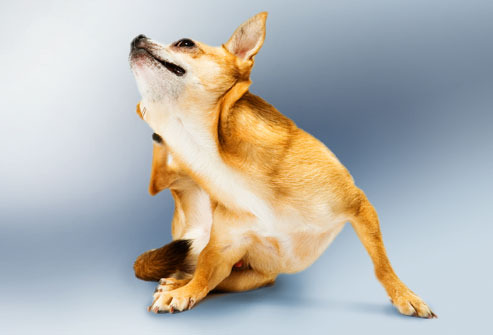
Dog Skin Problems
The sound of a dog constantly scratching or licking can be as irritating as nails on a chalkboard. But don’t blame your pooch for these bad habits -- a skin condition is probably the culprit. Possible causes range from parasites to allergies to underlying illness. WebMD has compiled images of some of the most common canine skin problems.
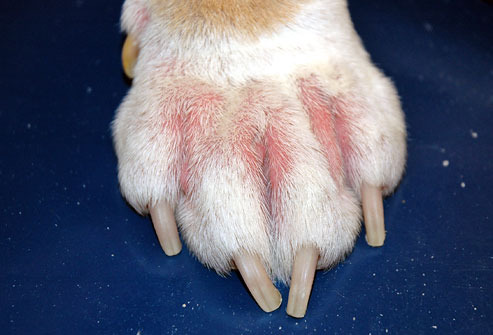
Allergic Dermatitis
Dogs can have allergic reactions to grooming products, food, and environmental irritants, such as pollen or insect bites. A dog with allergies may scratch relentlessly, and a peek at the skin often reveals an ugly rash. Corticosteroids or other, newer medicines can help with itchy rashes. But the most effective treatment is to identify and avoid exposure to the allergens.
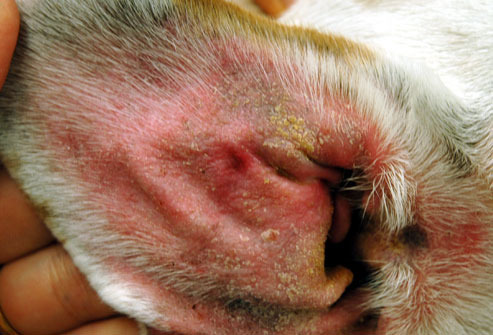
Yeast Infection
If your dog can't seem to stop scratching an ear or licking and chewing their toes, ask your veterinarian to check for a yeast infection. Symptoms include irritated, itchy, or discolored skin. The infection usually strikes the paws or ears, where yeast have a cozy space to grow. Yeast infections are easy to diagnose and often respond well to a topical cream. In some cases, your veterinarian may prescribe oral drugs or medicated baths.
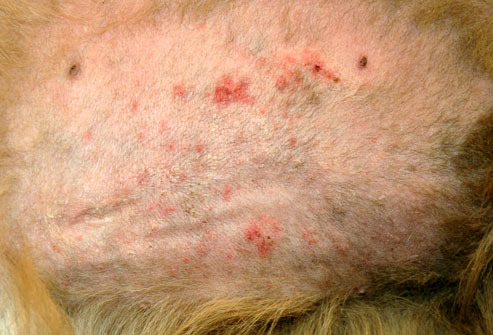
Folliculitis
Superficial bacterial folliculitis is an infection that causes sores, bumps, and scabs on the skin. These skin abnormalities are easier to see in shorthaired dogs. In longhaired dogs, the most obvious symptoms may be a dull coat and shedding with scaly skin underneath. Folliculitis often occurs in conjunction with other skin problems, such as mange, allergies, or injury. Treatment may include oral antibiotics and antibacterial ointments or shampoos.
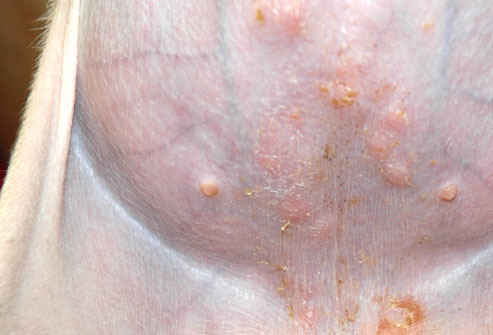
Impetigo
Another type of bacterial infection, impetigo is most common in puppies. It causes pus-filled blisters that may break and crust over. The blisters usually develop on the hairless portion of the abdomen. Impetigo is rarely serious and can be treated with a topical solution. In a small number of cases, the infection may spread or persist.
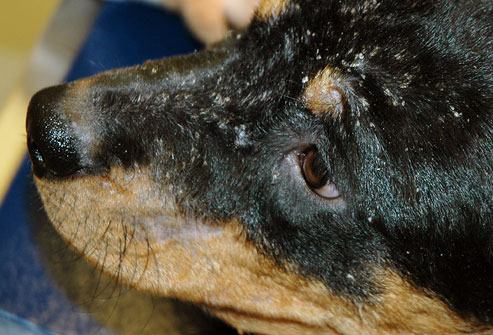
Seborrhea
Seborrhea causes a dog's skin to become greasy and develop scales (dandruff). In some cases, it's a genetic disease that begins when a dog is young and lasts a lifetime. But most dogs with seborrhea develop the scaling as a complication of another medical problem, such as allergies or hormonal abnormalities. In these cases, it is vital to treat the underlying cause so symptoms do not recur. The seborrhea itself typically can be treated with certain medicated shampoos.
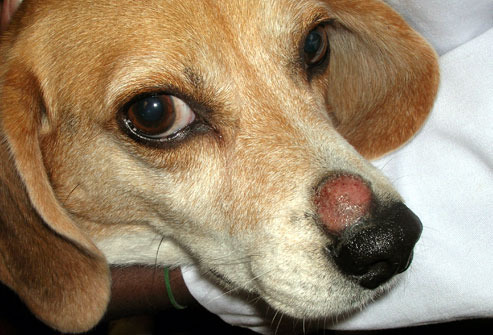
Ringworm
Despite its name, ringworm is not caused by a worm, but by a fungus. The term "ring" comes from the circular patches that can form anywhere, but are often found on a dog's head, paws, ears, and forelegs. Inflammation, scaly patches, and hair loss often surround the lesions. Puppies less than a year old are the most susceptible, and the infection can spread quickly between dogs in a kennel or to pet owners at home. Various anti-fungal treatments are available.
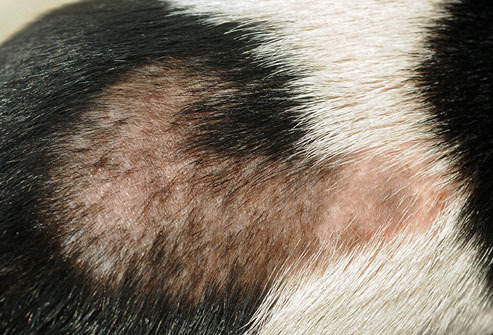
Shedding and Hair Loss (Alopecia)
Anyone who shares their home with dogs knows that they shed. How much shedding is normal depends on breed, time of year, and environment. But sometimes stress, poor nutrition, or illness can cause a dog to lose more hair than usual. If abnormal or excessive shedding persists for more than a week, or you notice patches of missing fur, check with your veterinarian.
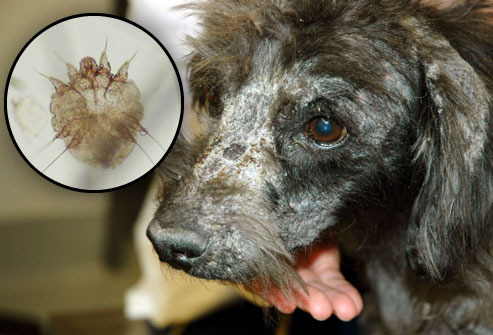
Mange (Mites)
Mange is a skin disorder caused by tiny parasites called mites. Sarcoptic mange, also known as canine scabies, spreads easily among dogs and can also be transmitted to people, but the parasites don't survive on humans. The symptoms are intense itching, red skin, sores, and hair loss. A dog's ears, face and legs are most commonly affected. Demodectic mange can cause bald spots, scabbing, and sores, but it is not contagious between animals or people. Treatment depends on the type of mange.
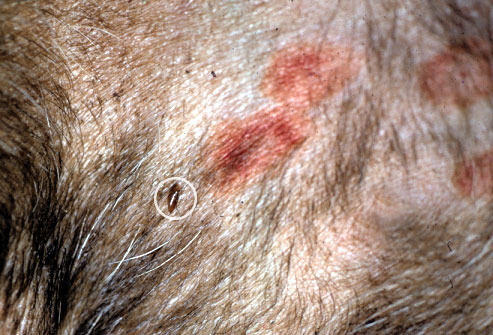
Fleas
Fleas are the bane of any pet owner. You may not see the tiny insects themselves, but flea droppings or eggs are usually visible in a dog's coat. Other symptoms include excessive licking or scratching, scabs, and hot spots. Severe flea infestations can cause blood loss and anemia, and even expose your dog to other parasites, such as tapeworms. Treatment may include a topical and/or oral flea killer and a thorough cleaning of the pet's home and yard.
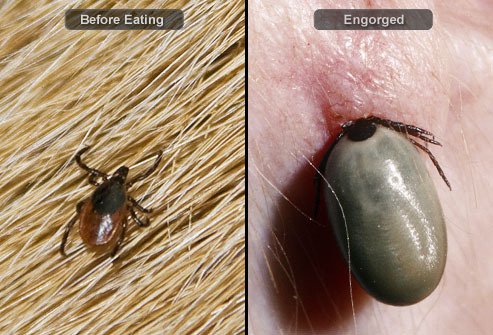
Ticks
Ticks, like fleas, are external parasites that feed on the blood of their hosts. You can spot a tick feeding on your dog with the naked eye. To properly remove a tick, grasp the tick with tweezers close to the dog’s skin, and gently pull it straight out. Twisting or pulling too hard may cause the head to remain lodged in your dog’s skin, which can lead to infection. Place the tick in a jar with some alcohol for a couple of days and dispose of it once it is dead. In addition to causing blood loss and anemia, ticks can transmit Lyme disease and other potentially serious bacterial infections. If you live in an area where ticks are common, talk to your veterinarian about tick control products.

Color or Texture Changes
Changes in a dog's skin color or coat texture can be a warning sign of several common metabolic or hormone problems. They can also result from an infection or other skin disorder. Usually a simple blood test can identify the underlying cause. Be sure to ask your veterinarian about any significant changes to your dog’s coat.
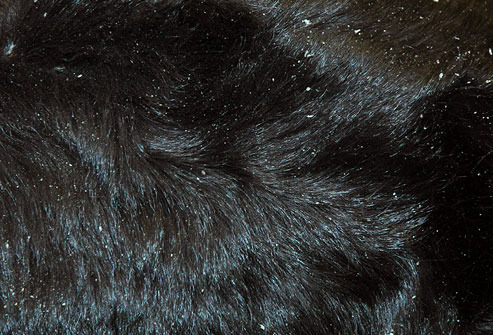
Dry, Flaky Skin
Dry, flaky skin can be a red flag for a number of problems. It's a common symptom of allergies, mange, and other skin diseases. But most often, dry or flaky skin is nothing serious. Make sure you are feeding Fido high quality food. Like people, some dogs simply get dry skin in the winter. If this seems to cause your pet discomfort, consult your veterinarian. Ask whether a fatty acid supplement or a humidifier might help.
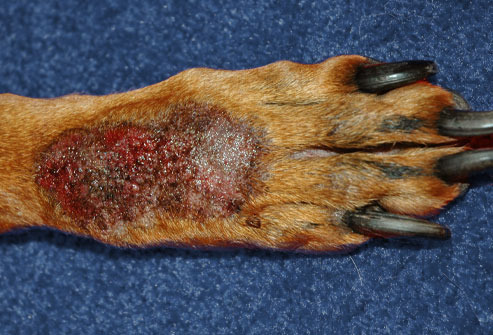
Acral Lick Granuloma
Also called acral lick dermatitis, this is a frustrating skin condition caused by compulsive, relentless licking of a single area -- most often on the front of the lower leg. The area is unable to heal, and the resulting pain and itching can lead the dog to keep licking the same spot. Treatment includes discouraging the dog from licking, either by using a bad-tasting topical solution or an Elizabethan collar. Also ask your dog's vet whether a medication like a topical or corticosteroid might help.
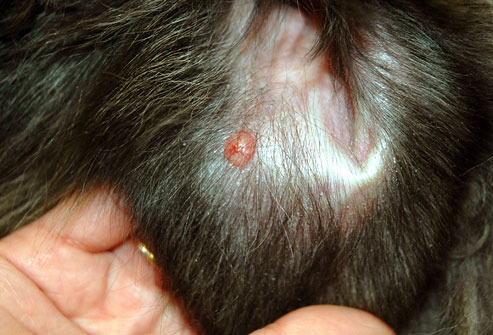
Skin Tumors
If you notice a hard lump on your dog's skin, point it out to your vet as soon as possible. Dogs can develop cancerous tumors in their skin. The only way to confirm a diagnosis of cancer is to biopsy the tumor. If the lump is small enough, your veterinarian may recommend removing it entirely. This can yield a diagnosis and treatment with a single procedure. For tumors that have not spread, this may be the only treatment needed.
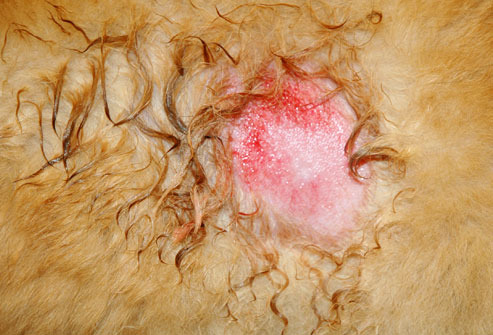
Hot Spots
Hot spots, also called acute moist dermatitis, are small areas that appear red, irritated, and inflamed. They are most commonly found on a dog's head, hips, or chest, and often feel hot to the touch. Hot spots can result from a wide range of conditions, including infections, allergies, insect bites, or excessive licking and chewing. Treatment consists of cleansing the hot spot and addressing the underlying condition.
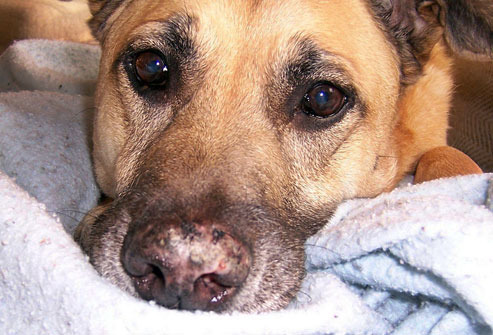
Immune Disorders
In rare cases, skin lesions or infections that won’t heal can indicate an immune disorder in your dog. One of the best known is lupus, a disease that affects dogs and people. Lupus is an autoimmune disorder, meaning the body’s immune system attacks its own cells. Symptoms include skin abnormalities and kidney problems. It can be fatal if untreated.
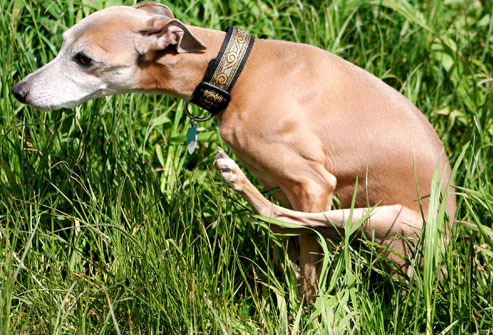
Anal Sac Disease
As if dog poop weren't smelly enough, dogs release a foul-smelling substance when they do their business. The substance comes from small anal sacs, which can become impacted if they don't empty properly. The hallmark of impacted anal sacs is a dog scooting their bottom along the ground. Other symptoms include biting or licking the anal area. A vet can manually express full anal sacs, but in severe cases, the sacs may be surgically removed.
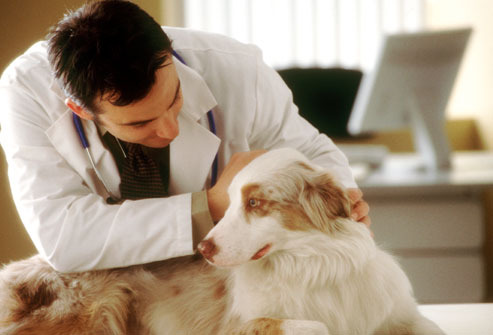
When to See the Vet
Although most skin problems are not emergencies, it is important to get an accurate diagnosis so the condition can be treated. See your veterinarian if your dog is scratching or licking excessively, or if you notice any changes in your pet's coat or skin, including scaling, redness, discoloration, or bald patches. Once the cause is identified, most skin problems respond well to treatment.
1 note
·
View note
Text
Dog Deshed
Many dog owners have certain ideas about what it means to be"doggy", which includes having all of their favorite accessories, such as hairstyles and accessories, placed on their own dog. You may even be able to catch him creating a new style, or perhaps he's decided that this is his way of showing that he is a part of your loved ones. Grooming the Dog: Though it's hard, it's a really rewarding and fun experience, but it is also a chore. You'll need to learn how to look after your dog how you want to be taken care of. You'll have to know how to groom, brush, rub down, and oil down your dog, or dog breed. The bottom line is that you can prevent dogs from suffering from teeth and gum problems by cleaning them frequently and lightly cleaning them with an air brush. By using one of the more effective dog grooming products, you can get rid of almost all of the pain and discomfort that your pet may be experiencing from their present state. With the right training, your dog will have the ability to follow the appropriate grooming procedures and get along well with dog hair styles. It's especially important to make the dog understand that you are the leader rather than them. Yeast infections can lead to skin irritations, which could then cause more pain. Needless to say, yeast infections are very common in dogs; it's just that not all dogs get them. Pet stores and online shops also sell dog shampoos. These shampoos are made for your pet and you can also find some that are for dogs. The reason you should take care of your pet's teeth and be extra cautious about cleaning their fur is because eating food containing bacteria that cause disease may result in illnesses. A dog that ingesting plenty of dog food that has been improperly cooked will have a greater probability of getting sick. In addition to this, you also need to look into the purchase price of the Chemicals-based Grooming products that you are going to buy. Most of the Grooming equipments which are Chemicals-based are likely to be expensive than those that aren't Chemicals-based. By knowing these grooming tips, you'll have the ability to get the most out of your dog's hair. If you wish to improve his behavior, then make certain you know the right grooming methods. He will always remember how to groom himself, even when you are not around. The fifth thing that you ought to be aware of is that the grooming hints should be done byusing scissors. Even though there are some tools that you may use, a knife will provide you the best results. Using a scissors is fine, but the knife will give you the best results because it's created specifically for the purpose of grooming your dog. Also, it is advised to use a pair of scissors or a pair of nail clippers so you will have more control on the hair. There are several different kinds of brushes and combs available in the market. It is up to you which sort of product you will be using to provide your dog. The more you understand about grooming, the better your dog will appreciate the experience. Pet deodorant is most likely the easiest and simplest way to eliminate nasty odors. You simply add a dab of it and spray down your dog. The good thing about it is that you don't have to worry about getting anything else while you're at it. It doesn't matter if you are outside or inside, there is no danger of staining your clothes or having your furniture damaged. There are lots of different reasons why people groom their pets' skin, hair and nails, yet, most people have one thing in common - they are using products that are created for pet grooming. If you haven't taken a look at a dog grooming manual in a little while, then you may be missing out on some great information on grooming. Here are some grooming facts that you should know about to get you started: Grooming is one of the Most Importantly things you should teach your dog. This will keep it on the straight and narrow and save you a lot of cash in pet supplies.
1 note
·
View note
Text
Dog Groomer
Dog grooming isn't a dog owner's only job. Dog grooming includes dog grooming, dog clothing and accessories, dog grooming products, dog grooming materials, dog grooming supplies, dog grooming tools, and so on. Some dogs will naturally fight back when their collars are eliminated, but other dogs do not care whether the collar is off or on. If the collar gets uncomfortable, then eliminate it quickly and easily. Dog grooming is a great thing to do, but you must remain mindful of how you do it. Good grooming is essential to keeping your dog in good health. Most Importantly, your Pet will enjoy a comfortable environment where he or she can relax. This means that you ought to use the proper grooming tools. Use a vanity and washcloth, not a carpet cleaner. Pet beds that do not wick moisture away are also a bad idea. The best way to trim the dog's nails is trim the nail completely before using scissors. Do not place the nail remover directly on the nail. When the nail is totally trimmable, it is possible to take scissors and cut it off. In this regard, you should consider the cost before you purchase the best Grooming equipments to your pets. The most important thing you need to remember while buying a Grooming product is to make sure that it is one that will work effectively for your dogs. You should start to groom your dog annually, but you need to give your dog a while to break every few weeks to allow for any build up of dirt and bacteria. You can also pick up some basic grooming tools in the neighborhood shop, like nail clippers, scissors, and combs which it is easy to make yourself, as you're most likely to find many other people in this class that are acceptable for your needs. Brush your pet's coat twice a week. Whether it is your dog's natural coat or its mane, it's important to brush your dog once a week. Yeast infections may lead to skin irritations, which could then cause more pain. Of course, yeast infections are extremely common in dogs; it is just that not all dogs get them. An Interesting point, why dogs should be groomed properly is due to grooming eliminates toxins in their hair. According to scientists, toxins accumulate in your dog's hair and skin. When your dog spends all its time at the grooming parlor, toxins and bacteria are washed away. Bear in mind that you shouldn't always pay for just 1 method of grooming. Just because you pay for the shampoo does not mean that you should pay for nail clipping or tooth brushing. This is because there are ways to help you to get the entire grooming therapy. It is good to visit the local veterinarian and ask them about the best method of cleaning your pet's teeth. You shouldn't use the teeth brush when dressing your dog as it can cause teeth damage. No matter what kind of dog you have, it will probably benefit your pet's hair to be brushed daily. You can start this by taking your dog for a walk outside and washing his jacket. Do not forget to groom your dog before leaving him out for a walk - this is where a regular trim will come in handy. Are you tired of your dog's routine shedding and have no clue what to do? There are several basic grooming routines that every fantastic groomer follows. All these routines can be learned with some basic materials and a bit of time. Continue reading for some great tips on grooming your dog.
1 note
·
View note
Text
Grooming for Dogs
If you need your dog to be healthy and to live a long life, you must take decent dog care. You need to take care of your dog so he doesn't have to deal with any kind of problem. You may read dog grooming tips on the best way to take good care of your dog so that you can spend more time with your pet. You may also want to consider finding someone who works at an animal shelter. You may be able to find someone that's working in a shelter that deals with dogs. This can be a good place to start. A Water dispenser is a vital part of your pet grooming kit as it is going to provide you with fresh and clean water that can help you do the basic grooming task easily. This section of the grooming kit is essential because it prevents any mess that you may make while performing the grooming task. Dog groomers work in many of approaches to clean up their customers' hairs. They might use exceptional products on the hair or might use brushes that concentrate on specific areas of the body. There are different types of products that dog groomers use to clean hair up - bar soaps, brushes, shampoo, lotions, oils, even pee. The market for Dog Grooming supplies is getting bigger by the day. As a dog owner, it is important that you use this latest market trend, so that you have the ability to reap the most benefits and not be left behind in this pet grooming business. I use to be rather hesitant about going to a dog groomer. I was fearful of giving them my money, thinking that they may not do a fantastic job and I would end up getting a poor-quality dog. What a nice surprise that was. You should not shampoo your dog's hair when it's still a puppy. This is due to the fact that different kinds of hair in dogs like hair from your dog's nails can be too much for the dog to take care of. In addition, it can be harmful for you and your dog if you aren't careful when grooming your dog. Yeast infections may lead to skin irritations, which can then cause more pain. Of course, yeast infections are very common in dogs; it's just that not all dogs get them. The Most Important way to care for the wrong type of dog nails would be to leave them alone and they'll grow in the direction that you want them to develop. This is not a good idea if you are attempting to get your dog to jump on you when you walk them Pet grooming tips for grooming dogs should be simple and comfortable. Doing this will let you do this job for many years to come. In case you're wondering what are the differences between the two styles, they are extremely similar. The only difference is that the blunt and topknot style does not cover the eyes of your dog. A good grooming session is a fantastic way to improve the health of your pet's skin and coat, help protect your pet from the damaging effects of exposure to various elements and give your dog a nice, clean appearance. While dog grooming is an important part of any dog owner's daily routine, here are some things you might want to think about when you decide to begin performing dog grooming for your dog. Get a Good Nutrition For Your Dog. What most people don't know is that dogs tend to get sick and have all sorts of problems because they are not getting enough nutrition. You need to feed your dog a good diet so they are active and healthy. Learning some dog grooming tips for pet care when you are pregnant is important, so be sure to follow this advice to make certain your pup has a healthy and happy pregnancy. Taking care of your pup during her pregnancy will decrease the quantity of time that she needs to remain in the vet's office.
1 note
·
View note